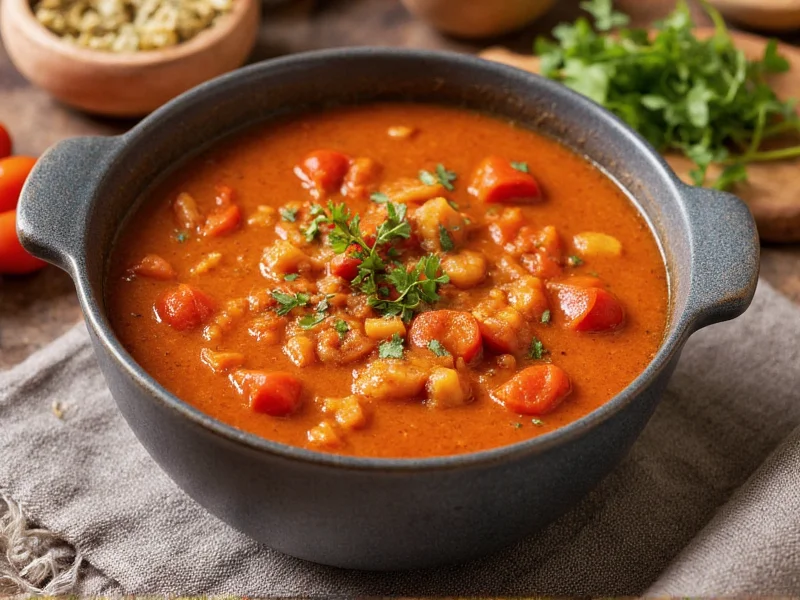Gulyas soup represents one of Hungary's most cherished culinary traditions, embodying centuries of pastoral heritage in the Carpathian Basin. Unlike the thicker, stew-like goulash familiar in many Western countries, authentic gulyas maintains a soupier consistency that reflects its origins as a meal prepared by Hungarian shepherds ("gulyás" in Hungarian) tending cattle on the Great Hungarian Plain.
The Historical Roots of Authentic Gulyas
The story of gulyas soup begins in the 9th century when Magyar tribes settled in the Carpathian Basin. Early versions were simple preparations made by herdsmen who would cook meat with available vegetables in a cauldron hung over an open fire. The distinctive red color and flavor came from sweet Hungarian paprika, which became a staple after peppers were introduced to Europe from the Americas in the 16th century.
Originally called "gulyásleves" (herdsman's soup) in Hungarian, this dish sustained workers spending weeks away from home. The traditional three-legged cast iron pot known as a "bogrács" remains essential to authentic preparation, allowing even heat distribution over open flames. This cooking method developed out of necessity, as herdsmen had limited equipment and needed meals that could simmer for hours while they tended livestock.
Authentic Gulyas vs. International Goulash Variations
Understanding the difference between authentic Hungarian gulyas and international goulash interpretations is crucial for appreciating this culinary tradition. Many countries have adapted the dish to local tastes, resulting in significant variations from the original.
| Characteristic | Authentic Hungarian Gulyas | Common International Variations |
|---|---|---|
| Consistency | Soup-like broth with visible liquid | Thick stew with minimal broth |
| Paprika Type | Sweet Hungarian paprika (sometimes with hot) | Often generic paprika or chili powder |
| Primary Meat | Beef (traditionally tougher cuts) | Variety including pork, sausage, or game |
| Vegetables | Onions, carrots, potatoes, peppers | Often includes tomatoes, beans, or pasta |
| Cooking Method | Slow-simmered outdoors in bogrács | Indoor pot cooking |
Essential Ingredients in Traditional Gulyas Preparation
The magic of authentic gulyas lies in its carefully balanced ingredients, each serving a specific purpose in creating the distinctive flavor profile. Unlike many international adaptations, traditional gulyas avoids tomatoes, which were historically unavailable to Hungarian herdsmen.
Beef selection typically includes tougher cuts like chuck or shank that benefit from slow cooking. The meat is cubed uniformly to ensure even cooking. Onions form the flavor base, caramelized slowly to develop sweetness before adding paprika. Sweet Hungarian paprika is non-negotiable for authentic flavor—never added directly to high heat to prevent bitterness. Caraway seeds provide the distinctive earthy note that distinguishes gulyas from other paprika-based dishes.
Additional traditional components include carrots, potatoes, green peppers, and sometimes diced tomatoes in modern variations. The soup finishes with a sprinkle of fresh parsley and a dollop of sour cream, though purists argue the sour cream should be optional.
Traditional Cooking Techniques for Authentic Gulyas
Preparing gulyas correctly requires understanding the sequence of steps that build flavor gradually. The traditional method follows these stages:
- Onion base: Slowly cook onions until golden to create sweetness
- Paprika addition: Remove from heat, add paprika to onions, then return to heat
- Meat browning: Add cubed beef and sear thoroughly
- Vegetable incorporation: Add carrots, potatoes, and peppers
- Slow simmering: Add water and simmer for 2-3 hours until meat is tender
- Final seasoning: Adjust with salt, pepper, and optional hot paprika
The slow cooking process allows collagen in tougher meat cuts to break down into gelatin, creating the soup's characteristic rich mouthfeel. Traditional preparation requires patience—rushing the onion caramelization or adding paprika to high heat will compromise the entire dish.
Regional Variations Within Hungary
While Budapest restaurants often serve refined versions, authentic gulyas varies across Hungary's regions:
- Great Hungarian Plain (Alföld): The birthplace of gulyas features the most traditional preparation with minimal vegetables
- Transdanubia: Often includes more root vegetables and sometimes a touch of tomato
- Upper Hungary (now Slovakia): May incorporate regional spices and slightly thicker consistency
- Székely Land: Known for adding sauerkraut to create "Székely gulyás"
These regional differences reflect local agricultural products and historical influences, yet all maintain the essential paprika-based broth that defines the dish. Modern Hungarian home cooks often adapt the recipe based on seasonal availability while preserving core elements.
Modern Interpretations and Common Misconceptions
As gulyas has gained international popularity, numerous misconceptions have emerged. Many believe goulash must contain potatoes and pasta, but traditional gulyas soup rarely includes either—potatoes are optional additions, and pasta (csipetke) appears in a separate dish called "goulash soup with pasta" rather than authentic gulyas.
Another common error involves paprika quality. Authentic Hungarian paprika comes from specific pepper varieties grown in the Kalocsa and Szeged regions, with distinct grades from sweet to hot. Substituting generic paprika or chili powder creates a fundamentally different flavor profile that misses the nuanced sweetness of genuine Hungarian paprika.
When prepared correctly, authentic gulyas offers a complex flavor experience where the paprika's sweetness balances the meat's richness, enhanced by the earthiness of caraway. The soup should have a deep red color without being overly spicy, with tender meat and vegetables that maintain their integrity after slow cooking.











 浙公网安备
33010002000092号
浙公网安备
33010002000092号 浙B2-20120091-4
浙B2-20120091-4